
Lake Tahoe is situated in the Sierra Nevada in the United States. It is a freshwater lake that is over 2 million years old. Furthermore, it is the biggest alpine lake in North America, with a depth of 1,645 feet, making it the second deepest lake in the United States. This lake is well-known for its crystal-clear water and the stunning mountains surrounding it. But what is in Lake Tahoe, and is it safe to swim?
Lake Tahoe is a big tourist attraction in California and Nevada. Also, it is popular because of its winter sports and summer outdoor activities. In addition, during winter, snow and ski resorts draw many visitors, and the Nevada side has many lakeside casino resorts to choose from.
Lake Tahoe’s water clarity has decreased in recent years. However, there are a variety of mammals, snakes, and fish to look out for when vacationing there. Over 3 million people visit this beautiful lake each year.
Water Quality Issues
Lake Tahoe is divided into two areas, nearshore and deepwater. Water clarity in the deepwater has declined by 30% since 1968, going from 100 feet to 64 feet. However, it has stabilized recently to an average of 65.2 feet. On the other hand, the nearshore has struggled with the proliferation of algae and other invasive animals and plants.
Lake Tahoe is listed under the Clean Water Act Section 303(d) as impaired by phosphorus, nitrogen, and sediment additions. These come mainly from:
- Atmospheric Deposition
- Stream Channel Erosion
- Urban Uplands Runoff
- Forested Upland Runoff
Some other issues facing Lake Tahoe include:
- Fire suppression and periodic drought cause approximately 25% of dead or dying trees.
- Destruction and alteration of wetlands.
- The establishment and threat of aquatic and terrestrial invasive species, such as the quagga mussel and Asian clam.
- The threat of catastrophic fire, insect infestation, and loss of biological diversity.

Lake Tahoe’s water clarity has decreased in recent years. However, there are a variety of mammals, snakes, and fish to look out for when vacationing there.
©iStock.com/heyengel
Mammals of Lake Tahoe
There are a wide variety of mammals that live around Lake Tahoe. Some of these are harmless, but some are to be avoided at all costs. They include the black bear, coyote, mountain lion, and porcupine.
Black Bear
Black bears are one of the most majestic animals that you can see near Lake Tahoe. They are omnivores but should be treated with respect, as they can become aggressive. A sighting of these bears should be valued. However, contact with humans must be avoided, as they could become reliant on human food and fail to secure food on their own.
Black bears live across North America and normally live in forests, mountains, and swamps. Additionally, they are excellent tree climbers and swimmers. Even though their name suggests they are black, they can also be brown, blue-gray, blue-black, cinnamon, or white.
These spectacular animals have a varied diet but are not picky because their main goal is to store as much body fat as possible before hibernating in the winter months. Their diet includes:
- Roots
- Berries
- Salmon
- Insects
- Moose
- Deer
- Carrion
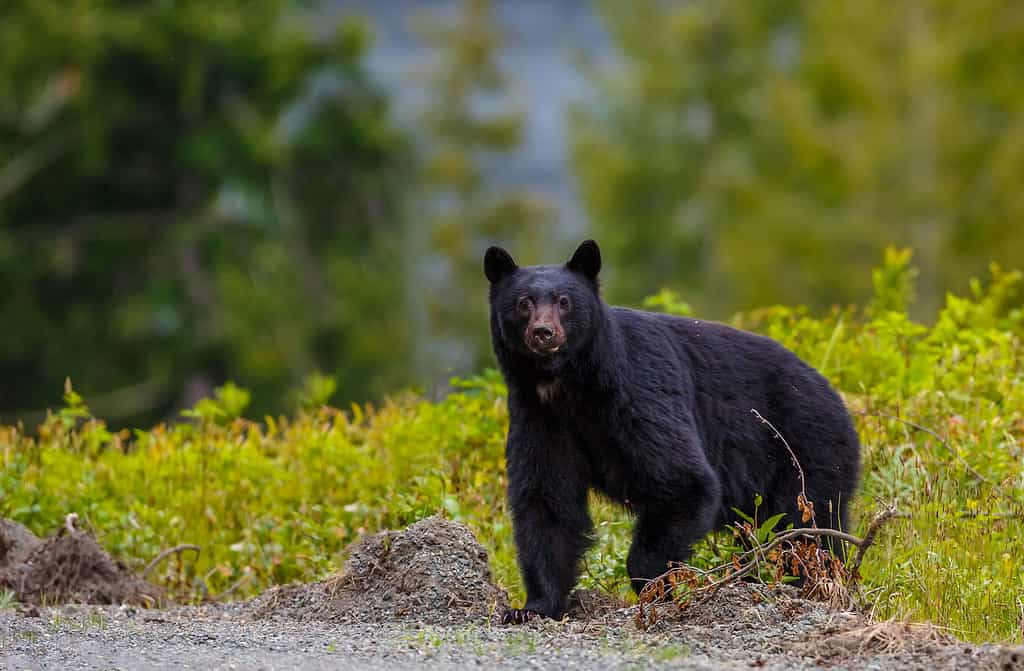
Black bears live across North America and normally live in forests, mountains, and swamps.
©Menno Schaefer/Shutterstock.com
Coyote
The clever coyote is a member of the dog family. They are renowned for their intelligence and for howling during the night. Coyotes occur throughout the United States. Furthermore, they like to live near people and often live near the edges of cities. These animals are somewhat like wolves, though they are smaller in size and have a lighter build. They can, however, weigh between 20 to 50 pounds. They have long, thick fur and bushy tails. Mainly they are grayish brown with white on their belly and throat. Coyotes are most active during the night and often hunt solo. They communicate with other coyotes using yaps, howls, and barks.
Coyotes have a varied diet, including:

Coyotes are most active during the night and often hunt solo.
©Warren Metcalf/Shutterstock.com
Mountain Lion
Mountain lions are known by several names, including puma, cougar, catamount, red tiger, deer tiger, and panther. They occur throughout North and South America. Additionally, they are considered one of the “big cats,” including leopards, tigers, lions, jaguars, and cheetahs. This is because of their strength, size, and predatory skills.
These “big cats” are carnivores and will stalk their prey until they can pounce on it. Additionally, they store their kill or hide it somewhere until they can feed on it, usually over a few days. Mountain lions do not roar, but the females have a loud screech that attracts males. Female mountain lions have, on average, about two to four cubs per litter and use a den to give birth. Cubs are normally born with spots that disappear when they are about nine months old.
Mountain lions have a poor sense of smell but excellent vision and hearing that assists them when hunting. They eat things like:

Mountain lions are known by several names, including puma, cougar, catamount, red tiger, deer tiger, and panther.
©Warren Metcalf/Shutterstock.com
Porcupine
The porcupine is a small plump rodent covered in quills. In fact, they can have more than 30,000 quills. Many people think that porcupines shoot their quills when threatened, but this is not the case. Instead, their quills detach when attacked and burrow into the attacker’s flesh. Furthermore, it is easy to spot when a porcupine is mad. It will hiss, stomp its feet, and shake its quills. However, they are not normally aggressive and will rather turn and run away.
These amazing creatures are mostly active at night. They are herbivores and will forage for the following:
- Plants
- Fruit
- Leaves
- Tree bark
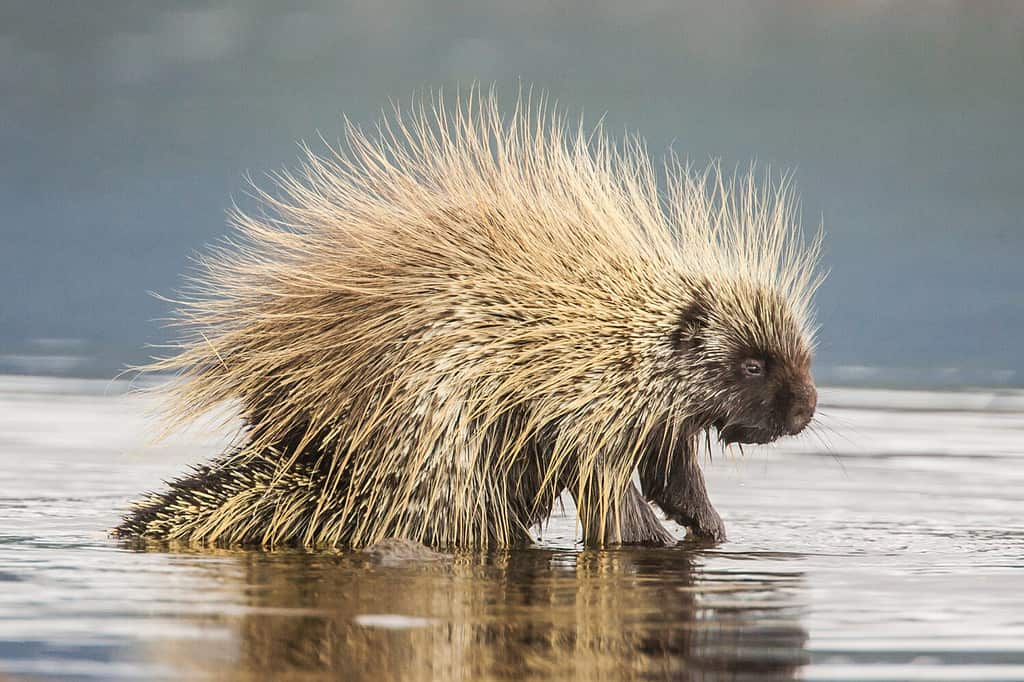
It is easy to spot when a porcupine is mad. It will hiss, stomp its feet, and shake its quills.
©Jukka Jantunen/Shutterstock.com
Snakes of Lake Tahoe
Lake Tahoe has many snake species, but none are water snakes. This lake primarily serves as a habitat for rattlesnakes, but you can also find other species, such as the rubber boa, western yellow-bellies racer, and the great basin gopher snake.
Great Basin Rattlesnake
All rattlesnakes are venomous and should be treated with respect. The great basin rattlesnake has a thin neck, heavy body, and large triangular head. They are also known as pit vipers because they have two pits on either side of their heads just above their mouths. They are average-sized for a rattlesnake yet very easily camouflaged. In addition, they prefer dry areas but can also be spotted on rocky outcrops or in stony canyons.
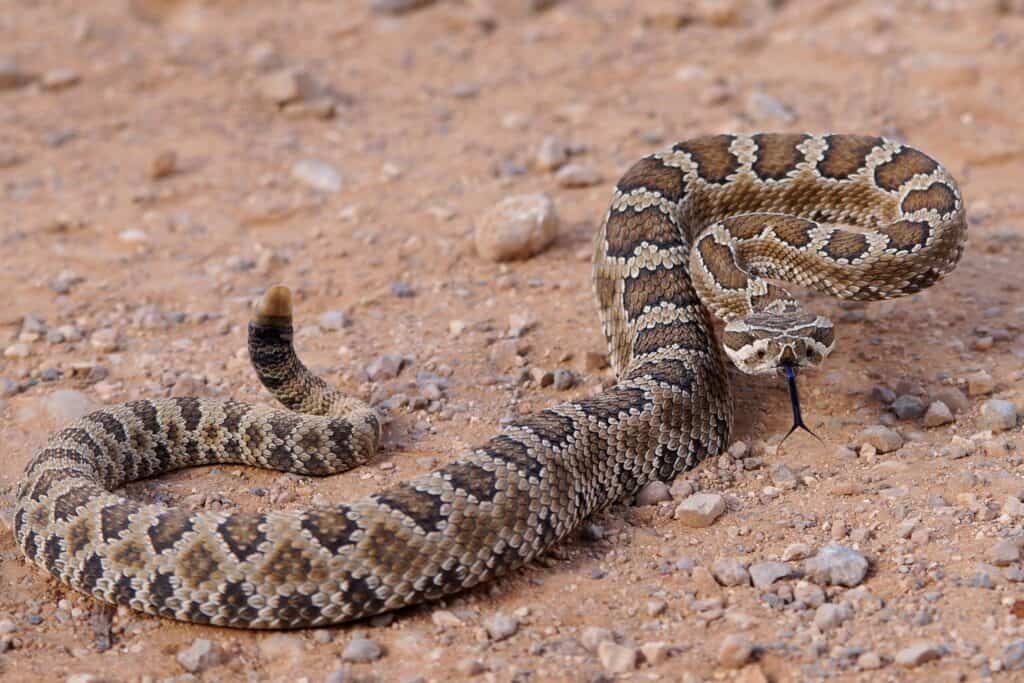
The great basin rattlesnake has a thin neck, heavy body, and large triangular head.
©Matt Jeppson/Shutterstock.com
The Rubber Boa
The rubber boa is indigenous to North America. It is also known as the Northern Rubber Boa or Coastal Rubber Boa. These snakes can grow up to 26 inches and are usually dark brown. Furthermore, they have light yellow bellies. Their tales mirror their heads, and this is a sight to behold.
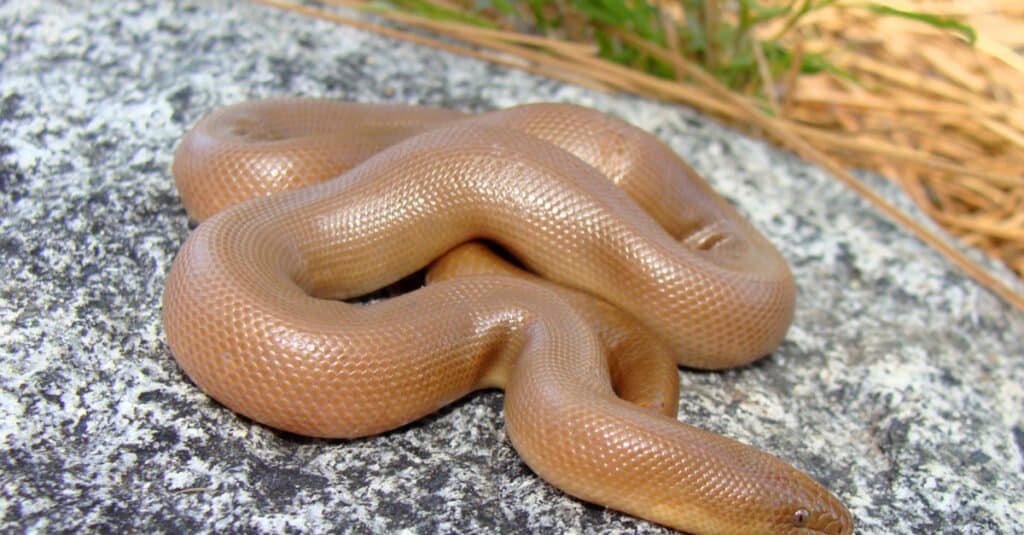
The rubber boa inhabits areas around Lake Tahoe; they are also called the northern rubber boa or coastal rubber boa.
©Matt Jeppson/Shutterstock.com
Western Yellow-Bellied Racer
The western yellow-bellied racer is a subspecies of the eastern racer snake. These snakes are endemic to North America and occur in Colorado, California, Nevada, Montana, Oregon, Utah, and New Mexico. Interestingly, they get their name from their yellow bellies, but adults are green to gray. They can grow to a length of 75 inches. Furthermore, they are very skittish, so if you spot one around Lake Tahoe and would like a photograph of it, you will have to move very slowly so you do not scare it off.
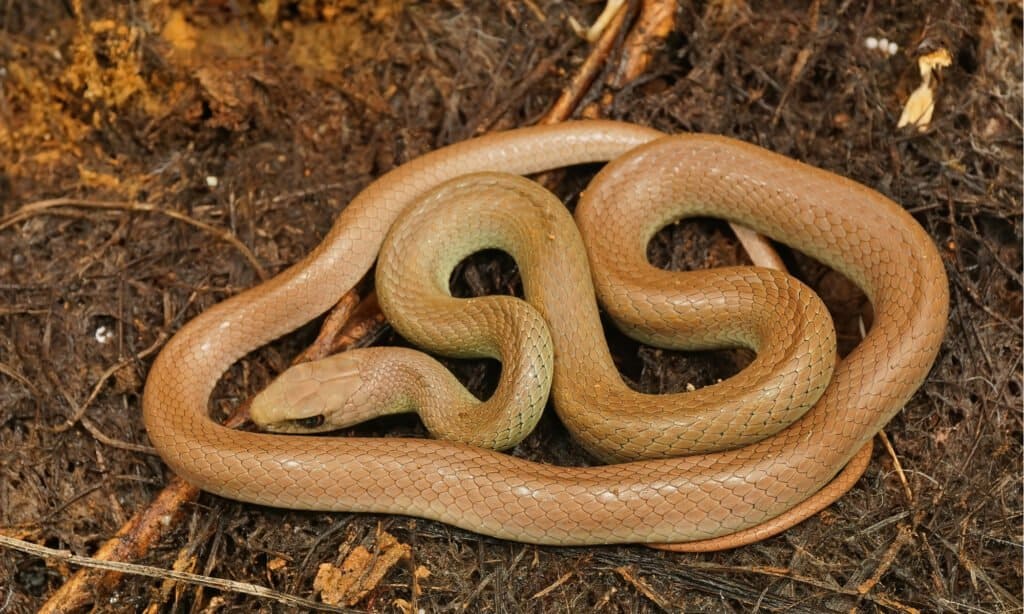
These snakes are endemic to North America and occur in Colorado, California, Nevada, Montana, Oregon, Utah, and New Mexico.
©HWall/Shutterstock.com
Great Basin Gopher Snake
The great basin gopher snake occurs across Nevada and likes to live in forests, shrubs, and grasslands. Adult snakes can grow up to 5 feet long. They have narrow heads but wide necks. Furthermore, they are mostly yellow or cream with large quadrangular brown or black spots on their side. These snakes are active day and night but prefer warm weather. They will eat small mammals such as rabbits, gophers, and mice. The easiest way to know if you are near to a great basin gopher snake is the loud hissing sound that it makes. However, they are not venomous but steer clear just to be safe.
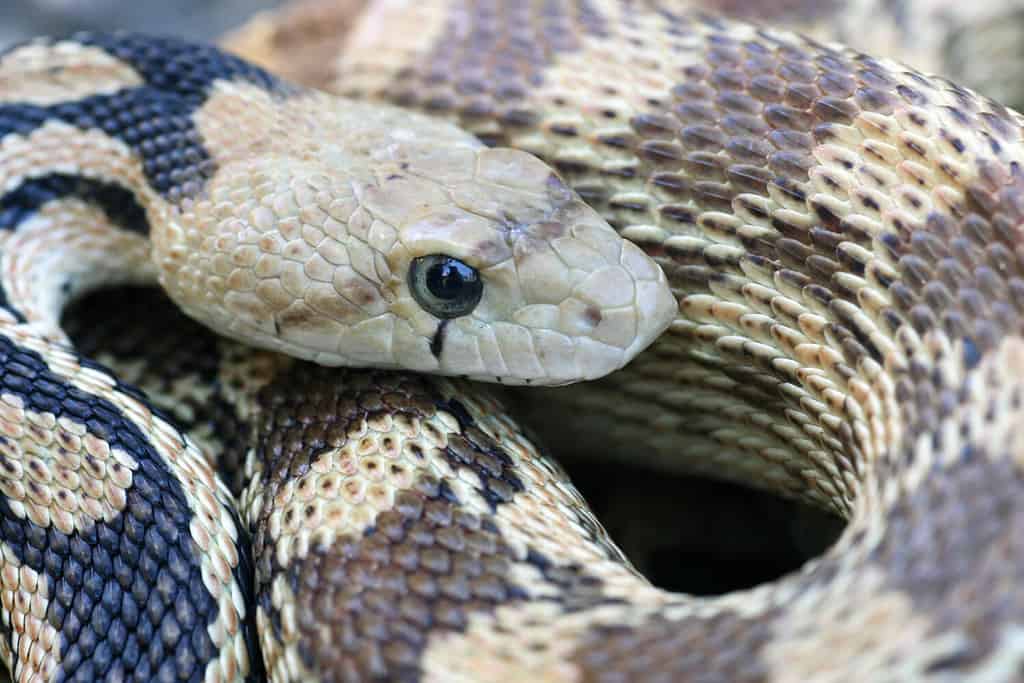
The great basin gopher snake occurs across Nevada and likes to live in forests, shrubs, and grasslands.
©Michael Benard/Shutterstock.com
Fish in Lake Tahoe
Lake Tahoe’s water is very clear because pure rainwater enters the lake. Therefore, it is a haven for fish and has many species, including rainbow trout, largemouth bass, and Paiute sculpin.
Rainbow Trout
Lake Tahoe is home to rainbow trout because it does not drain into the ocean. In addition, it is one of America’s most popular fish with anglers. This trout is identifiable by the rose-colored strip that runs down its side. Furthermore, there is the popular local Tahoe Trout Farm at Lake Tahoe, where kids can try to catch fish. Additionally, fishermen can take up to five rainbow trout out of Lake Tahoe daily.
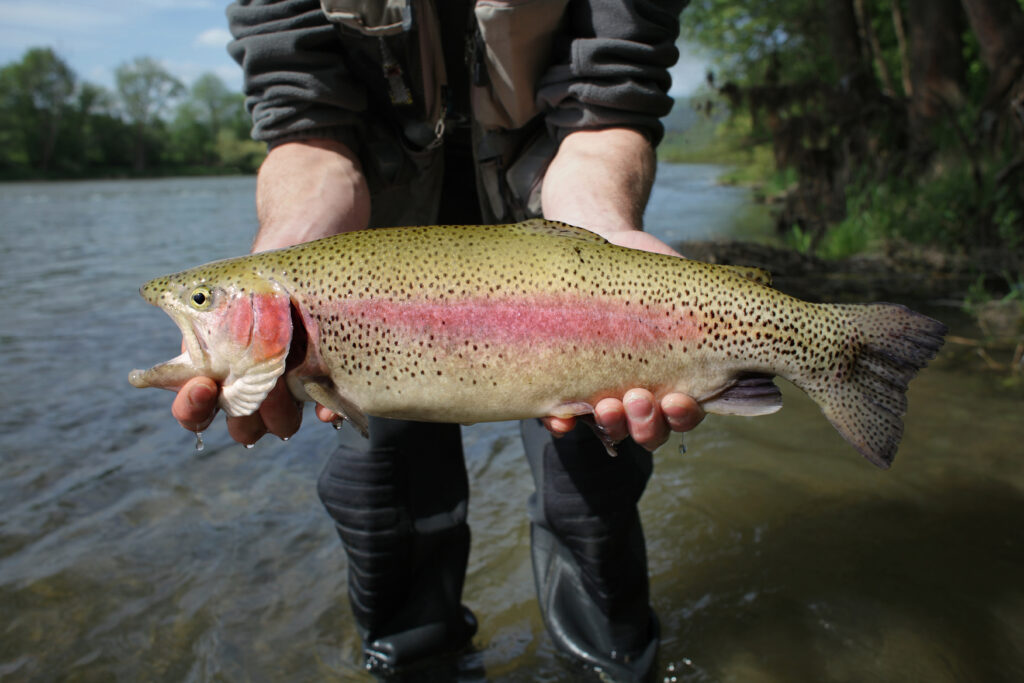
Fishermen can take up to five rainbow trout out of Lake Tahoe daily.
©pictoplay/Shutterstock.com
Largemouth Bass
The largemouth bass is a large sunfish and the most in-demand catch in the United States with anglers. Their name comes from the size of their mouths and their ability to devour large prey. Additionally, they can grow to a length of 38 inches. Lake Tahoe is a perfect fit for largemouth bass because of its crystal-clear water, which they prefer. These fish will eat other fish, leeches, birds, small mammals, amphibians, and insects.
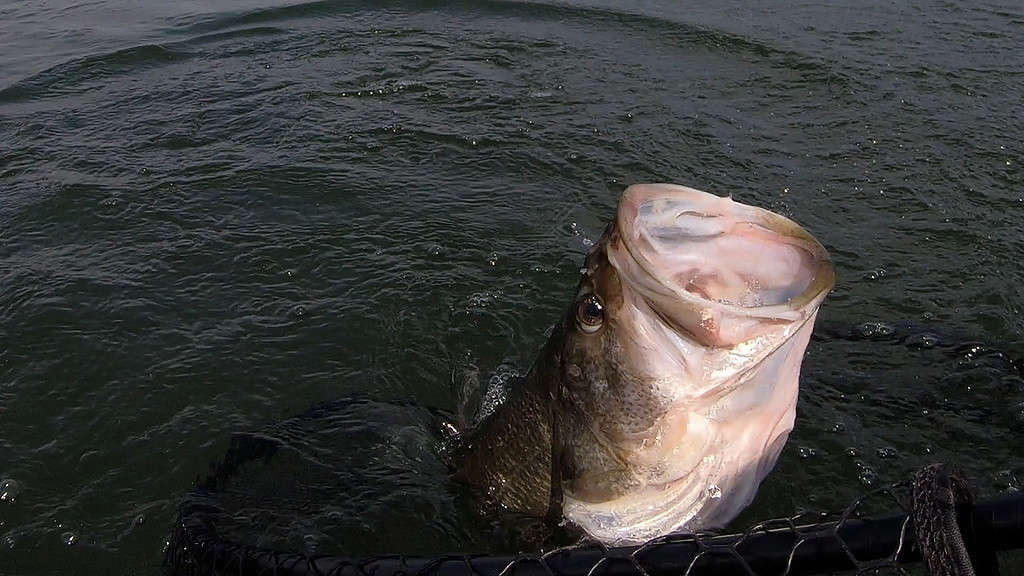
The largemouth bass is a large sunfish and the most in-demand catch in the United States with anglers.
©iStock.com/Mr Bass Outdoors
Paiute Sculpin
Sculpins are fascinating fish that have enormous mouths and wide fan-like pectoral fins. They use these fins if they are captured to try to scare off their attackers. However, they are harmless and relatively small. They like to be at the bottom of lakes, where they feed on crustaceans and aquatic insects. Lastly, they are not normally caught for sport but are unique and intriguing to see when a fisherman does catch one by accident.
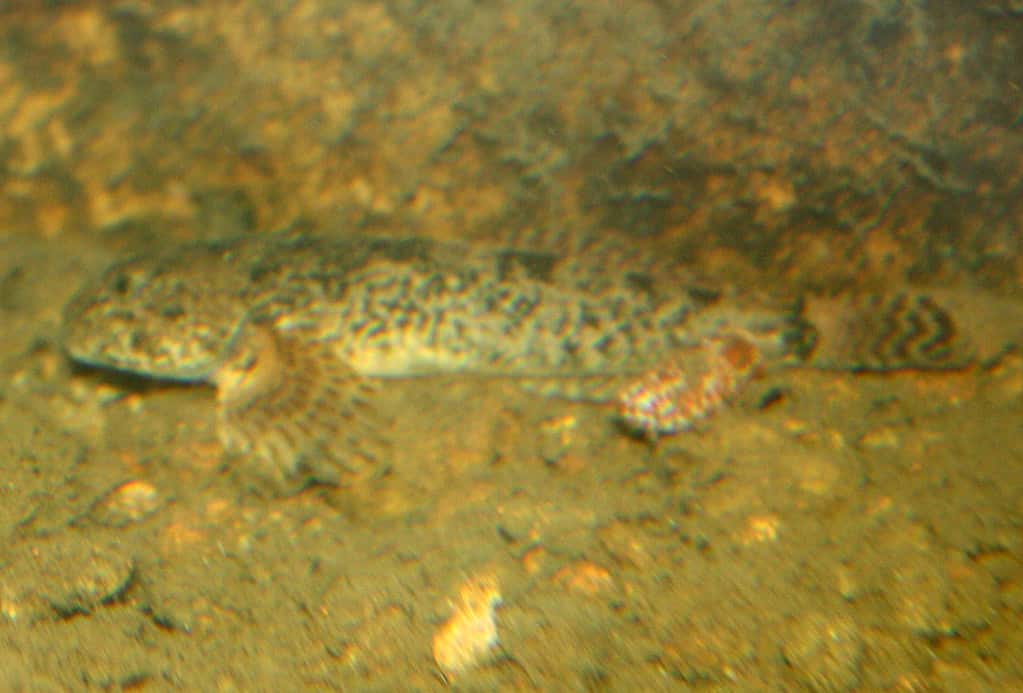
Paiute Sculpinmin murky water.
©{{{1}}} / CC BY 2.0 – License
Is Lake Tahoe Safe to Swim In?
In short, yes, it is normally safe to swim in Lake Tahoe. Just be sure to wear boots when walking around the lake. The most common snake you might see in the lake is a garter snake. If you do happen to see a snake swimming in the lake, just let it pass by, as they are normally not venomous.
The photo featured at the top of this post is © topseller/Shutterstock.com
Thank you for reading! Have some feedback for us? Contact the AZ Animals editorial team.






